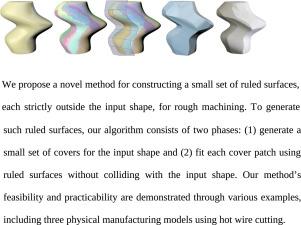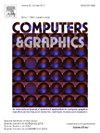用于粗加工的具有直纹表面的雕刻形状
IF 2.8
4区 计算机科学
Q2 COMPUTER SCIENCE, SOFTWARE ENGINEERING
引用次数: 0
摘要
我们提出了一种新的方法来构造一组小的直纹曲面,每个都严格在输入形状之外,用于粗加工。为了生成这样的直纹曲面,我们的算法包括两个阶段:(1)为输入形状生成一组小的覆盖,(2)使用直纹曲面拟合每个覆盖补丁,而不与输入形状发生冲突。由于法向沿其中一个主曲率方向变化最快,而直纹曲面不能沿其直纹方向变形,使得法向变化最快的主曲率方向与直纹曲面正交,更有可能在使用直纹曲面拟合曲面时增加覆盖面积。同时,我们可以沿着另一个主曲率方向形成基曲线。因此,我们的掩体生成步骤是由一个近似于主曲率方向场的光滑交叉场驱动的。第二阶段的核心是基于优化的拟合,以自适应地减小逼近误差,同时保持直纹曲面与输入形状不冲突。通过三种热丝切削物理制造模型,验证了该方法的可行性和实用性。本文章由计算机程序翻译,如有差异,请以英文原文为准。

Carving shapes with ruled surfaces for rough machining
We propose a novel method for constructing a small set of ruled surfaces, each strictly outside the input shape, for rough machining. To generate such ruled surfaces, our algorithm consists of two phases: (1) generate a small set of covers for the input shape and (2) fit each cover patch using ruled surfaces without colliding with the input shape. Since the normal changes fastest along one of the principal curvature directions and the ruled surfaces cannot be deformed along their rulings, making the rulings and the principal curvature direction where the normal changes fastest orthogonal is more likely to increase the cover areas when using ruled surfaces to fit the surfaces. Meanwhile, we can trace another principal curvature direction to form the base curve. Accordingly, our cover generation step is driven by a smooth cross field approximating the principal curvature direction field. Central to the second stage is an optimization-based fitting to adaptively reduce the approximation error while keeping the ruled surfaces collision-free with the input shape. Our method’s feasibility and practicability are demonstrated through various examples, including three physical manufacturing models using hot wire cutting.
求助全文
通过发布文献求助,成功后即可免费获取论文全文。
去求助
来源期刊

Computers & Graphics-Uk
工程技术-计算机:软件工程
CiteScore
5.30
自引率
12.00%
发文量
173
审稿时长
38 days
期刊介绍:
Computers & Graphics is dedicated to disseminate information on research and applications of computer graphics (CG) techniques. The journal encourages articles on:
1. Research and applications of interactive computer graphics. We are particularly interested in novel interaction techniques and applications of CG to problem domains.
2. State-of-the-art papers on late-breaking, cutting-edge research on CG.
3. Information on innovative uses of graphics principles and technologies.
4. Tutorial papers on both teaching CG principles and innovative uses of CG in education.
 求助内容:
求助内容: 应助结果提醒方式:
应助结果提醒方式:


